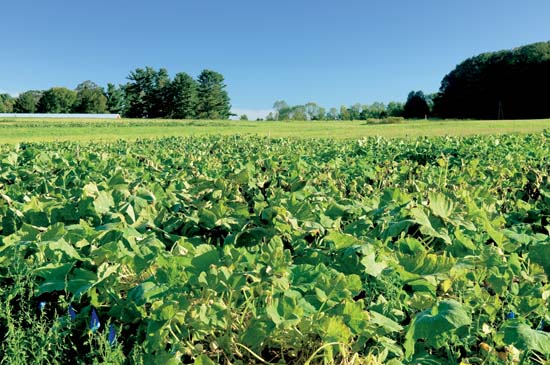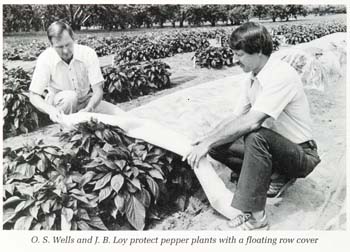 |
 |
| current issue |  |
past issues |  |
send a letter/news |  |
address update |  |
advertise |  |
about us |  |
alumni home |
Features
The MatchmakerPage 2 of 4

|
Loy's bush squash hybrids were a success, and his work soon attracted the attention of New York-based agricultural supply company Agway, which approached him with a proposal to market and distribute his seeds. That sounded fine to Loy, who, still early in his UNH career, was more interested in his breeding work and teaching plant biology classes than becoming a commercial success.
Loy's initial partnership with Agway would turn out to be the beginning of a commercial juggernaut. Some four decades later, the companies he partners with stretch around the globe, from Johnny's Selected Seeds in Maine to seed companies in China and New Zealand that sell his melon, squash, gourd, pumpkin and tomato hybrids. About 20,000 pounds of his pumpkin seeds alone are sold each year—producing some 120 million pounds of pumpkins. One of his melon hybrids, due to its adaptability to the arid Middle East climate, is the leading cantaloupe crop in Saudi Arabia. And although the majority of them were developed for Northeast growing conditions, Loy's cucurbit varieties can be found growing in places as far flung as Russia, Spain, South Africa, Bulgaria, Serbia, Moldova, Uzbekistan and Turkey.
At UNH, Loy's success can be measured in the most concrete of terms. Since 1999, he has earned more than $1.1 million in royalties for the university's Office for Research Partnerships and Commercialization, which was established to capitalize on the commercial potential of university research projects. While the office was established with an eye toward high-tech disciplines such as computer science and ocean and space engineering, it is Loy's work that has made the biggest mark. Over the past 12 years, his plant hybrids have accounted for approximately one-fifth of the university's license agreements and half of the total royalties. Last year, in recognition of his work, Loy received UNH's first Innovator of the Year award. In future years, the award will bear his name.
 UNH Archives
UNH ArchivesHERITAGE: Plant biology professors Otho Wells, left, and Brent Loy in a 1987 photo. |
Loy has also won national breeding trophies, and his All-American Honey Bear hybrid squash has been a semifinalist twice for the national Agriscience Award. But what brings him out to Kingman Farm every day is the desire to help local farmers. "There are so many things that can impact the success of a harvest, and many are factors we now can breed for," he says. He has bred resistance to powdery mildew into many of his hybrids, for example, improved their nutritional content and increased uniformity in size and ripening time.
"There's such an extraordinary genetic variability in plant traits," Loy says. "You have to have an almost spiritual relationship with the plants you grow to understand how to bring out their optimal qualities."
Loy's relationship with his plants begins at the UNH greenhouse complex off Main Street. In January, in the only greenhouse with an "Authorized Personnel Only" sign on the door, he beds down the seeds that will become his parent plants. Into the spring, the seedlings are checked daily—if not by Loy himself then by one of his assistants, most likely master's candidate Jake Uretsky '12G or research technician Hua Cui '05G, '09G. Then, as the snow melts and the fields begin to color up, they prune and feed, string up lengths of sisal baling twine for the growing vines to climb, and monitor the production of flowers that might give rise to their first round of hybrid fruit. The process of creating a first generation, or F1, hybrid is painstaking and deliberate—a horticultural arranged marriage of sorts.
In early spring, once he's identified which two parent plants are carrying the different genetic traits he would like to cross, Loy chooses a "ready" female flower—easily identified by the immature fruit beneath the blossom—that he will hand pollinate with a corresponding male flower. The day before the female is set to open (the giveaway is a certain coloring to the petals, he says, and the slightest parting of the furled bud), he will clip together the tips of the petals with a pliable metal tab roughly the size of a pencil eraser. The following morning, he will remove the tab and pick his male flower, stripping away the petals to expose the pollen-laden stamen, and brush its pollen grains against the female's stigmatic surface. It's the birds and the bees in the most literal sense, minus the bees. (In the field, where bees are an issue, Loy prevents natural pollination with white mesh bags.) If the fertilization is successful, the female ovary will soon tell the story, swelling to form the growing pumpkin or squash or cantaloupe.
Page: 1 2 3 4 Next >
Easy to print version
blog comments powered by Disqus
